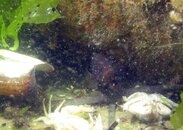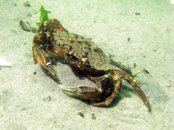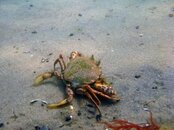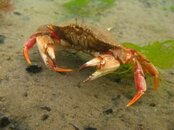You're way too far away from your subjects. In all of the shots. Get closer, closer, and then a little bit closer. The difference between two feet and one foot? HUGE!!! Seriously. You will see much improvement.
As far as focus goes, make sure the camera is set to center spot focus. The so-called evaluative AF or "smart AF", where the camera decides what to focus on was one of the most unfortunate ideas a camera engineer ever had and the person responsible still deserves to be shot. This function is bad on land, but underwater is about as useful as a flooded housing. Then, focus on the eyes of the animal, hold the shutter button halfway depressed to lock the focus and then recompose the picture and shoot. That way, next time you take a picture like the one on your desktop, the crab's face will be in focus. The pincers might not, but that's better than having the eye out of focus. Focus on an animal's eye gets first priority. Always. The only exception are nudibranchs, where you can focus on the cerata. And perhaps there might be the very rare exception in which you prefer to focus on something other than the eyes, but I can't think of too many situations. The "eye in focus" rule is a good one to start with.







